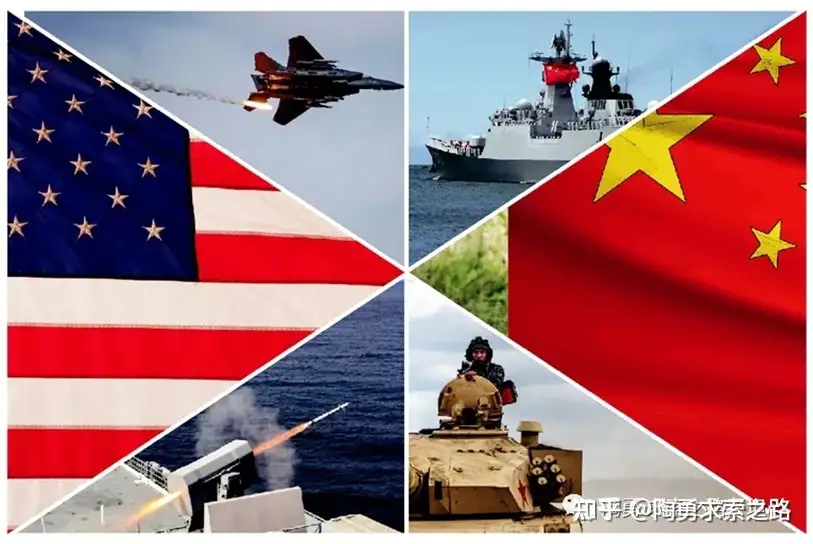兰德智库报告:大国战争的回归
——美中两国系统性冲突的情景
The Return of Great Power War
Scenarios of Systemic Conflict Between the United States and China

CHAPTER EIGHT
第八章
Conclusion
结论
The prospect of China overtaking the United States to attain a position of international pri-macy may be remote. It appears unlikely, but it is not impossible. Whether it happens or not will depend on an interplay of geopolitics, economics, demographics, and many other fac-tors, the outcome of which lies beyond the scope of this report. Other RAND studies have suggested that China may experience mediocre growth and never muster the strength to overturn the U.S. position. This may well be the case. But if China should surprise the world and move closer to a position of global primacy, the implications for U.S. security could be tremendous. The United States has been the world’s premier power for so long that it is dif-ficult to imagine a world in which it no longer maintains that position.
中国超越美国取得国际首要地位的前景可能十分渺茫——这似乎不太可能,但也并非绝对不可能!中国是否超越美国取得国际首要地位取决于地缘政治、经济、人口和许多其他因素的相互作用——这个结果点预测超出了本报告的范围。兰德智库的其它研究表明,中国可能会经历平庸的增长、永远难以积蓄力量颠覆美国地位——这可能是不争的事实!但如果中国出乎世界意料,更接近全球霸主地位,那么对美国安全的影响可能是巨大的。美国长期以来一直是世界头号强国,所以,打死你都难以想象一个居然没有美国保持霸主地位的世界是神马样纸?
This report has sought to tentatively explore what a situation of potential power transi-tion featuring an adversarial China that has achieved a position of near global primacy might mean for U.S. security. To be sure, it is possible to imagine, as others have done, scenarios of peaceful power transition. However, we have focused on the grim possibilities that such a transition would be contested and bitterly fought. Data on a hypothetical situation may be scarce, but they are not completely absent. We have sought to present facts and data that could help illuminate how such a situation might unfold.
本报告试图浅显探讨美中之间存在的潜在权力过渡局势——一个已取得近乎全球霸主地位的敌对中国对美国安全可能意味着什么?可以肯定的是,正如其他人所做的那样,我们有可能想象权力和平过渡的情景。然而,我们关注的是这样一种严峻的可能性,即这种过渡将是有争议的、激烈的拼斗。有关假设情况的数据可能很少,但并非完全没有——我们试图通过事实和数据来说明这种情况可能会如何发生。
Report Summary
报告摘要
Trends in global politics and economics provide the most basic reason for the possibility of some sort of power transition. The gap in comprehensive national power between China and the United States is expected to narrow in the coming years, and the size of China’s economy could well surpass that of the United States in nominal terms, though it will continue to lag behind the United States in per capita terms. The rise of the non-West and the decline of the West raises the prospect of an unsettled international order that will likely bear little resemblance to that of the past two centuries, which were dominated by Western powers. An increasingly multipolar world could result in shifting partnerships and alliances, which, combined with the rise of the developing world, might open new opportunities for China to expand its base of international power. The evolution of the global economy in a direction that could feature Asia and China in a central role could further expand opportunities for China. The role of BRI countries in particular could shift the scene of major political and military confrontations to those countries.
全球政治和经济的发展趋势为某种权力过渡的可能性提供了最基本的理由。中国与美国之间的综合国力差距预计将在未来几年缩小,中国的经济规模在名义上很可能超过美国,但在人均方面仍将落后于美国。非西方国家的崛起和西方国家的衰落带来了国际秩序动荡不安的前景,这看起来跟过去两个世纪由西方大国主导的国际秩序几乎没有相似之处。一个日益多极化的世界可能导致伙伴关系和联盟的变化,再加上发展中世界的崛起,可能为中国扩大其国际权力基础带来新的机遇。全球经济朝着以亚洲和中国为中心的方向发展,将进一步扩大中国的机遇。尤其是“一带一路”倡议国家作用,可能会出现重大政治和军事对抗舞台向这些国家的趋势。
Military trends provide another source of insight into the potential evolution of a systemic U.S.-China conflict. Analysts have outlined reasons to expect war to grow more protracted, to involve society, and to overlap with transnational threats and nontraditional conflict. Advanced militaries continue to innovate and develop new technologies and capabilities that raise the possibility of future conflict featuring a higher degree of AI, unmanned systems, and long-range precision strike capabilities. These features could characterize conflict sce-narios involving both China and the United States.
军事趋势发展为洞察美中系统性冲突的潜在演变提供了另一个视角。分析人士列出了一些理由,预计可能爆发的美中战争将变得更加旷日持久,涉及社会,并与跨国威胁和非传统冲突重叠。先进的军事力量不断创新和发展新技术和能力,使未来冲突有可能出现更高程度的人工智能、无人系统和远程精确打击能力——这些特点可能成为涉及美国与中国冲突情景的特征。
How might China initiate and manage conflict under conditions of international pri-macy, especially regarding its chief rival? Patterns in warfare and geopolitical control by pre-vious great powers provide some data that we can draw from for insight. The Soviet Union, the United Kingdom, and the United States all established a geopolitical base of power, which China seems poised to do in its focus on BRI regions. Past great powers also varied in their efforts to control other countries, with more recent trends favoring a reliance on informal methods of control, an approach consistent with recent Chinese practices. Patterns in con-flict between past powers also suggest that China may be inclined to favor direct and indirect interventions on behalf of client states over direct aggression, imperial conquest, and formal incorporation of territory.
我们需要知道的是,在国际优势条件下,中国会如何发起(事实上是应对——译者注)和管理冲突,尤其是针对其主要竞争对手的冲突?我们从以往大国的战争和地缘政治控制模式提供的一些数据中,获得相关启示。苏联、英国和美国都建立了地缘政治的权力基础,而中国似乎也准备在“一带一路”倡议重点地区建立这样的权力基础。过去的大国在控制其它国家的做法方面也各不相同,最近的趋势是倾向于依赖非正式的控制方法,这种方法与中国最近的做法一致。过去列强之间的冲突模式也表明,中国可能倾向于代表客户国进行直接或间接干预,而不是直接侵略、帝国征服和正式合并领土。
The onset of U.S.-China hostilities could also follow observed patterns of preceding rival great powers. The multiplication of intractable disputes, polarization of views, deepening of threat perceptions, and multilateralization of rivalries could all mutually aggravate hostile sentiments and incentivize leaders in both nations to declare the other a top threat. Such a move would likely be accompanied by accelerating arms buildups and an intensified effort to cultivate alliances and partnerships. In an atmosphere of intense hostility and fear, the risk of escalation in any military crisis could surge dramatically.
美中敌对行动的爆发也可能遵循以往大国竞争的模式。棘手争端的增加、观点的两极分化、威胁感的加深以及竞争的多边化都会相互激化敌对情绪,促使两国领导人宣布对方为最大威胁。与此同时,两国很可能会加速军备集结,并加大力度培养联盟和伙伴关系。在充满敌意和恐惧的气氛中,任何军事危机升级的风险都可能急剧上升。
Chapter Five featured a shift toward scenario analysis. We examined how the PLA might modify elements of its modernization program to prepare for a potential major war with the United States. We projected that the PLA might favor the buildup of long-range munitions and low-cost weaponry for use by client militaries in its preparations. Chinese leaders could direct broader efforts to distribute arms to client states ahead of time and might rely on civil-ian contractors to augment PLA capacities to transport troops and equipment around the world.
第五章的特点是情景转变分析。我们研究了解放军如何修改其现代化计划的内容,以准备跟美国可能爆发的大规模战争。我们预测,解放军在备战过程中可能会偏向于集结远程弹药和低成本武器,供客户军队使用。中国领导人可能会尝试更广泛的努力,提前将武器分销给客户国,并可能依靠民营承包商来增强解放军在世界各地运输部队和装备的能力。
In Chapter Six we synthesized the findings from the preceding chapters to create a sce-nario of systemic U.S.-China low-intensity conflict. The decision to initiate hostilities, even in an indirect form, would represent a dramatic escalation in tensions between the two coun-tries. As we have proposed, China’s war aims in such a situation could be the gradual attri-tion of U.S. power to the point where the latter could no longer pose a credible threat to China’s efforts to realize its goals of national revitalization. Military operations could take the form of operations to damage and weaken the power of the United States and its allies indirectly while advocating for cooperation on shared threats and the continuation of trade. While the PLA might favor support to host nation forces as a means of minimizing the risks of escalation, the PLA could get involved in combat operations alongside client armies. The prospect of conflict involving PLA forces would be highest along China’s periphery, where the projection of forces would be easiest given the PLA’s limited expeditionary capability. However, low-intensity conflict could encompass a broad range of operations, including technical and advisory support to host nation militaries. An environment in which Chinese and U.S. forces did not engage each other directly could free China to deploy fairly sub-stantial military forces in client states as far away as the Americas, although China would probably favor indirect support in the form of arms sales and the furnishing of military and technical advice to such distant clients. In between China’s periphery and the most distant regions, PLA forces could project power in a limited fashion to support combat operations undertaken by client militaries in Africa, the Middle East, South Asia, and southern Europe. Civil war and interstate war could result in Chinese and U.S. assistance to their clients as well. The possibility of occasional direct engagements by Chinese and U.S. platforms cannot be discounted given the close proximity in which the forces might be operating. Conflict could extend to the homelands of each country, primarily in the form of cyberspace and information domain struggles. However, fear of uncontrolled escalation in cyberspace and outer space provides a strong incentive for both sides to limit attacks in those areas. The relatively modest resource commitments of a low-intensity war raise the prospect of chronic warfare lasting many years, especially if the two adversaries found ways to stabilize rela-tions, occasionally collaborate on shared threats, and maintain global commerce even as they waged indirect conflict.
在第六章中,我们综合了前几章的研究结果,提出了美中低强度系统性冲突的设想。决定发起敌对行动,即使是间接形式的敌对行动,也将意味着两国紧张局势的急剧升级。正如我们所提出的,在这种情况下,中国的战争目标可能是逐步削弱美国的实力,使其不再对中国实现民族振兴目标的努力构成实质威胁。军事行动的形式可以是间接破坏和削弱美国及其盟国的力量,同时倡导合作应对共同威胁并保持贸易往来。虽然解放军可能倾向于支持东道国军队,以尽量降低冲突升级的风险,但解放军也可能与客户国军队一起参与作战行动。解放军部队卷入冲突的可能性最大的地区是中国周边地区,因为解放军的远征能力有限,在那里投送兵力最为容易。然而,低烈度冲突可能包含广泛的行动,包括为东道国军队提供技术和咨询支持。在中美两国军队不直接交战的环境下,中国可以在远涉美洲的客户国部署相当规模的军事力量,尽管中国可能更倾向于以军售和向这些远方客户提供军事装备和技术咨询进行间接支持。在中国周边和最遥远的地区之间,解放军部队可以有限度地投射力量,支持非洲、中东、南亚和南欧客户军队的作战行动。内战和国家间战争也可能导致中国和美国向其客户提供援助。鉴于中美两国军队的行动距离很近,中美两国平台偶尔直接交战的可能性不容忽视。冲突可能会延伸到两国本土,主要表现为网络空间和信息领域的斗争。然而,对网络空间和外层空间失控升级的恐惧令双方在很大程度上限制在这些领域的相互攻击。低烈度战争耗费的资源相对较少,因此即便持续多年的长期战争也不至于耗尽国力——特别是如果美中两个交战对手找到了“磨而不裂”稳定彼此关系的方法,“边打边谈”——偶尔就共同威胁进行合作(诸如反恐、气候变化等——译者注)、并在双方间接冲突的同时维持全球贸易(比如“中美贸易战”等——译者注)。
In Chapter Seven, we explored a scenario of high-intensity systemic conflict. Policymak-ers who have tired of the chronic, indecisive fighting of a low-intensity war could be lured by the promise of a rapid and decisive victory to escalate the conflict through high-intensity warfare. The principal goal of such a war would be to rapidly destroy the warfighting capac-ity of the adversary and thereby render its chances of victory extremely unlikely. The advent of conventional major combat operations would in many ways represent the escalation of a war of power transition to a decisive stage. Given the stakes and the polarized political atmosphere exacerbated by mounting casualties and destruction inflicted by the adversary power, further escalation of the conflict could prove difficult to resist. High-intensity war would probably overlap with a continuation or exacerbation of low-intensity conflict around the world and feature multiple feuds and rivalries. A destabilized global economy could aggravate transnational problems and add to the complex and unsettled security environ-ment in which the war would be waged. Chinese military forces would prefer to fight a con-ventional war with U.S. forces close to the country’s shores, perhaps near Taiwan or other flash points in the first island chain, where the PLA’s arsenal could be largely brought to bear. But direct combat engagements could also break out along the vulnerable sea lanes passing through the Malacca Strait and the Indian Ocean as Chinese military forces fought to protect vulnerable merchant traffic and defeat potential U.S. threats long those routes. While such battles would be waged largely by air and maritime forces, Chinese ground forces could collaborate with air and naval forces to seize and control vital choke points in East Africa and the Middle East.
在第七章中,我们探讨了高强度系统冲突的情景。政策制定者厌倦了低烈度战争中之长期优柔寡断的拼斗,也许被迅速取得决定性胜利的虚幻所诱惑,于是,通过高烈度战争使冲突升级。这种战争的主要目标是迅速摧毁对手的作战能力,从而使其获胜的可能性变得微乎其微。常规大规模作战行动的出现在许多方面代表着美中权力过渡战争升级到决定性阶段。鉴于事关重大,而且敌对势力造成的伤亡和破坏不断增加,加剧两极分化的政治气氛,冲突进一步升级之诱惑难以抵挡。高烈度战争很可能与世界各地低烈度冲突的延续或加剧相叠加,并以多方争斗和竞争为特征。全球经济的不稳定会加剧跨国问题,使战争环境更加复杂和动荡。中国军队倾向于在靠近中国海岸的地方与美军打一场常规战争,也许是在台湾或第一岛链的其他热点附近,在那里解放军的武器库可以发挥很大作用。但直接交战也可能在通过马六甲海峡和印度洋的脆弱海道沿线爆发,因为中国军队要保护脆弱的商船运输,并消除美国在这些航线上的潜在威胁。虽然此类战斗主要由空军和海军发动,但中国地面部队也可与空军和海军合作,夺取并控制东非和中东的重要咽喉要道。
Implications for the Department of Defense
对(美国)国防部的启示
This report carries several implications for U.S. decisionmakers, analysts, and planners. First, planners may need to consider a broader range of contingencies for both low-intensity and high-intensity war. Second, planners may need to view the possibility of serial conflicts when contemplating combat contingencies involving China. Third, the United States should con-sider bolstering its ability to wage indirect war. Fourth, the analysis of high-intensity war has underscored the importance of ensuring that the United States has the ability to defend and secure vital choke points in the Middle East and along the Indian Ocean. Fifth, U.S. plan-ners contemplating potential scenarios of chronic U.S.-China conflict may want to focus on the possibility of Chinese-manned A2/AD systems in client militaries and irregular combat.
本报告对美国国防部战争决策者、分析师和规划者有几点启示。首先,规划者可能需要在更广大的范围考虑可能引发低烈度冲突或高烈度战争之突发事件诱因、以防微杜渐。其次,国防部战争规划者在考虑涉及中国的战争突发事件时也许需要研究连续冲突的可能性。第三,美国应考虑加强发动间接战争的能力。第四,对高强度战争的分析强调确保美国有能力保卫中东和印度洋沿岸咽喉要道的重要性。第五,美国计划者在考虑美中长期冲突的潜在情景时,可能需要关注中国在客户军队和非正规作战中部署反介入和区域阻绝武器系统 (Anti-access and area-denial) 的可能性。
Department of Defense (DoD) planners should contemplate a broader range of possible conflict scenarios involving China beyond traditional hot spots such as Taiwan. While most of the conflict scenarios discussed in this report consist of indirect, low-intensity combat, we have also examined clashes between Chinese and U.S. forces in the Indian Ocean and in the Middle East. These are, of course, merely illustrative examples, not predictions. But China’s determination to establish its base of power along BRI routes raises the possibility of clashes occurring throughout a much broader geographic region than traditional analysis tends to consider.
除台湾等传统热点地区外,国防部(DoD)规划人员应考虑更多可能涉及中国的冲突情况。虽然本报告中讨论的大多数冲突情景都是间接、低强度的战斗,但我们也研究了中美两军在印度洋和中东地区的冲突。当然,这些只是示例,并非预测。但中国决心在一带一路沿线建立自己的力量基地,这就提出了研究超过传统分析更广阔的地理区域内发生冲突的可能性。
DoD planners may need to consider the possibility that any conflict scenario with China will entail a series of clashes spread over a broad area and over a long period of time, perhaps lasting years. The systemic nature of U.S.-China conflict as outlined herein provides a strong incentive for both sides to engage in low-intensity war in many parts of the world even if they also engage in high-intensity war near Taiwan or other conventional flash points. Con-ventional clashes near Taiwan could also coincide with high-intensity wars along the Indian Ocean or even extend to vital choke points in East Africa and the Middle East. War is also likely to extend to cyberspace and possibly outer space, even as challenges from nontradi-tional threats could continue to stress the military capacity of the warring parties. A situation featuring systemic low-intensity conflict could also last many years, following the precedent set by the Cold War.
国防部的规划者可能需要研究这样的可能性,即与中国的任何冲突都将导致在广泛地区和长时间内发生一系列冲突,也许会持续数年之久。
本文概述美中冲突的系统性为双方在世界许多地区进行低烈度战争提供了强大动力,即使他们也在台湾或其他常规热点附近进行高烈度战争。台湾附近的常规冲突也可能与印度洋沿岸的高强度战争同时发生,甚至延伸到东非和中东的重要咽喉。
战争还可能延伸到网络空间,甚至可能延伸到外层空间,而来自非传统威胁的挑战可能会继续对交战各方的军事能力造成压力。系统性低烈度冲突的局面也可能延续多年,似乎遵循冷战先例。
DoD planners and decisionmakers may want to focus more effort on indirect conflict. The relatively modest cost and more limited disruption posed by low-intensity war make this form of conflict more plausible, at least in the near term. Yet analysis of how the United States could conduct such operations remains nascent. More study of possibilities for building part-nerships and helping partners defend themselves against state-backed threats in countries along BRI routes could expand opportunities to defend China’s own interests and limit its ability to assert its primacy along vital economic corridors in Eurasia.
国防部的规划者和决策者可能希望将更多精力放在研究间接冲突上。低烈度战争的成本相对较低,造成的破坏也较为有限,因此至少在近期内,这种冲突形式较为可能出现。然而,有关美国如何开展此类行动的分析研究仍处于起步阶段。更多的研究放在建立合作关系的可能性,并帮助合作伙伴在一带一路沿线国家抵御政府支持的威胁,这可能会扩大中国捍卫自身利益的机会,并限制其在欧亚重要经济走廊维护其主导地位的能力。
DoD planners should consider integrating analysis of operations to secure vital choke points in the Middle East with analysis of potential U.S.-China combat operations. Because of the importance of these choke points for China’s ability to secure its Indian Ocean ship-ping route, Beijing could be motivated to direct major combat formations to seize control of vital canals and maritime routes. The possibilities of conventional combat over these features raises the imperative to include analysis of these regions in planning for major U.S.-China conflict contingencies.
国防部规划人员应考虑把确保中东重要咽喉要道安全的行动分析与潜在的美中作战行动分析结合起来。由于这些咽喉要塞对中国确保其印度洋船运路线安全的能力十分重要,中国政府可能会主动指挥主要作战编队夺取重要运河和海上通道的控制权。在这些地区进行常规战争的可能性使我们必须把对这些地区的分析纳入美中冲突重大突发事件的计划中。
Finally, U.S.-China conventional conflict scenarios outside the first island chain could consist mainly of engagements between ISR sensors and modest-size units of long-range strike systems, as well as potential clashes involving irregular and proxy forces. Planners who seek to anticipate such scenarios may want to focus on weapons and platforms that help gain the information advantage, and attacking from a long range could be the most helpful. Alli-ance building to develop counterinsurgency and to counter such forces could also be useful for such scenarios.
最后,美中在第一岛链以外的常规冲突场景可能主要由包括情报、监视、侦察传感器与远程打击系统的中等规模部队之间的交战,以及涉及非正规部队和代理部队的潜在冲突组成 试图预测此类情况的规划者可能希望将重点放在有助于获得信息优势的武器和平台上,远距离攻击可能最有帮助。为发展反叛乱和反击此类部队而进行的盟友关系建设对此类情况也很有用。
References
参考文献(略——译者)
NATIONAL SECURITY RESEARCH DIVISION
(南德智库)国家安全研究部
结语:
Through a careful synthesis of current and historical data on relevant factors, anticipated trends, and research-grounded speculation, the authors analyze several scenarios of systemic U.S.-China conflict under hypothetical conditions in which China has neared the point of global primacy. Drawing on academic and research findings regarding the potential trajectory of international security and warfare in coming years, China’s approach to future warfare, relevant experiences of preceding great powers, and historic patterns in interstate wars, they explore the possibility of a U.S.-China war of power transition. The authors develop two scenarios of systemic U.S.-China conflict. The first scenario features a low-intensity conflict that unfolds across much of the world, across many domains and over many years. The second features a high-intensity war that evolved out of the low-intensity war. The high-intensity war scenario envisions aggressive actions by both countries to destroy the war-fighting capability of the adversary and carries an extremely high risk of escalation to the most destructive levels.
通过仔细综合相关因素的当前和历史数据、预期趋势以及基于研究的推测,作者分析了在中国已接近全球霸主地位的假设条件下系统性美中冲突的几种情景。
作者根据未来几年国际安全与战争的潜在轨迹的学术研究成果、中国对未来战争的态度、前几任大国的相关经验以及国家间战争的历史模式,探讨了美中权力交接战争的可能性。作者提出了两种系统性美中冲突的情景。第一种情景是在世界许多地方、许多领域和许多年内展开的低强度冲突。第二种情景是由低烈度战争演变而来的高烈度战争。高强度战争情景设想两国采取侵略行动,摧毁对手的作战能力,并极有可能升级到最具破坏性的程度。这两种情况都发生在国际局势严重分裂的背景下, 中美两国军队在应对一系列非传统威胁、满足陷入困境的伙伴国的援助要求的同时,还要维持战争努力,因此承受着巨大的压力。尽管他们的分析涉及的是中国已接近全球霸主地位的假想冲突局势,但他们的研究结果甚至可以为今天潜在突发事件的国防规划提供参考。


 红歌会网 SZHGH.COM
红歌会网 SZHGH.COM

 粤公网安备44030002003979号
粤公网安备44030002003979号
